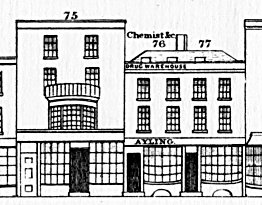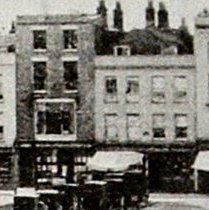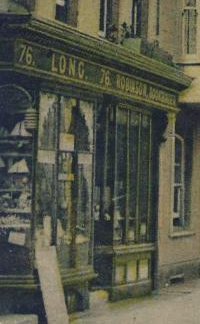
Nos. 75 - 77 High Street

These three properties face onto Grand Parade and as such held a prominent position on High Street. The image of them (see right) from the Strangers Guide by Charpentier (1842) show them to be typical structures for the period and their location. They appear in a number of drawings and photographs dating back to the 1860s and so we have some evidence for how they might have changed in the period between 1842 and 1860. As it happens they had altered very little between those dates, as can be seen from the rather indistinct image (below) taken from the ramparts in 1860.
Once again, we can see from a comparison between this image and the Charpentier drawing that the latter cannot be relied upon to faithfully represent accurate proportions of any building. In this case, the photograph of No. 75 shows it to be a lot taller and narrower than depicted in Charpentier.

The photograph is too indistinct to offer much information about the precise configuration of the ground floor shop windows, but there is a hint that they are divided into series of small panes. As far as is known, there are no further images of No. 75 from around 1860 from which more detailed information could be derived.
There is however further evidence of Nos. 76 and 77 which can be gleaned from a photograph taken in the 1930s (below, right). Although this is more than 70 years after our target date there is good reason to believe that the shop front to No.76, if not the original, is closely modelled on it. Plainly there is a difference in the configuration of window panes in the shop front, but the overall areas occupied by them seem similar.

Another photograph taken from the ramparts around 1870 gives a strong indication that the several small window panes shown in Charpentier had given way to a few large panes by that date and so could have been in place in 1860. We know from earlier research that the use of large panes of glass was quite common on the High Street of the 1860s. One feature that seems to have survived the passage of time is the semi-circular window to the basement of No. 76; an identical structure being illustrated in Charpentier. In contrast, the shop front to No.77 has been somewhat remodelled, but once again it features the large plate glass windows.
Documentary Evidence
In the 1861 Census, Schedule 66 lists Joseph Treakell (70, married) as head of household (the FindMyPast transcription misspells the name as "Sawkill"). There is no record of a wife present at that time but a son James (37) and daughter Dinah (34), both unmarried, are living in the house. Also present on the night of the census were a lodger Mary Agee (25), a servant Maria Gray (24) and three visitors.
Schedule 67 lists only one family in what must be the record for both Nos. 76 and 77 as the following Schedule can be firmly tied to No. 78 High Street. The family is headed by George W. Vick (FindMyPast lists him as "Wick") who was 34 years old and a tailor employing 1 man and 1 boy. The rest of the household comprises of his wife Annie (31), daughter Emma (9), mother Emma (60) and Louisa Redley (19) who is also described as a daughter.
Kelly's (1859) Directory confirms that Sch. 66-67 refers to Nos. 75-77 High Street by reporting that Joseph Treakell, Music Seller, was resident at No.75 and GW Vick, Tailor and Insurance Agent for Royal Fire lived at No. 76. The 1859 Post Office directory confirms both references. Hunt's 1852 directory provides evidence that both Treakell and Vick had been present in the area for several years, Treakell at No. 74 High Street (which may have been a transcription error) and Vick at 37 High St. and St. Thomas's Street.
Simpson's (1863) again confirms the presence of Joseph Treakell at No.75 but also lists Deliah Gardner, confectioner at No.76 and George William Vick, outfitter at No. 77. Harrod's (1865) lists Joseph Treakell at No. 75 and Deliah Gardner at No. 77.
Summary
The evidence for the usage of these properties is consistent across several references whilst the main photograph is as contemporary as we could wish. All three buildings were used as retail outlets for a variety of businesses and as such used large shop windows to display their wares. What is in some doubt is the configuration of the windows as at some stage the small panes had given way to large sheets of plate glass. Given the prominence of these buildings opposite Grand Parade it seems probably that they would have been in the vanguard of the conversion to plate glass which was certainly happening elsewhere on High Street. The photographic evidence suggests that this had happened at Nos. 76 and 77 by the 1860s but No.75 may have kept smaller panes until later. This is how it will be handled in the model.